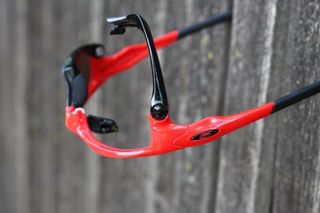You can trust Cyclingnews







Use of Oakley’s Jawbone sunglasses spread like wildfire throughout bike racing’s ranks since their introduction in 2009. Their usefulness doesn’t discriminate between pavement and dirt, nor has their acceptance. The new Split Jacket takes the features of Jawbone and squeezes them into a smaller package. The new glasses will be available this July.
First and foremost, the Split Jacket features Oakley’s Plutonite HDO lenses, made from a proprietary polycarbonate that makes their optics exceptionally clear, and offers great contrast and depth perception without causing any eye fatigue – even during all day use. They are probably some of the best lenses we’ve looked through. The fit is solid and comfortable, and the glasses stay put.
Split Jacket’s smaller package makes it a good sunglass for the road, in our opinion. It also makes a more seamless transition between your exploits on the bike and off. Its smaller size definitely draws less attention than its big brother, but it also fogs up more easily. The point is that there are tradeoffs to each benefit.
It all comes down to the fact that the larger Jawbone provides more coverage and a greater lower field of view, plus the option of vented lenses. Thus we have to consider it a better sport sunglass. Over the shoulder peripheral vision is about the same for both styles, yet inferior when compared to the Radar model’s lack of lower frame on its lens.
Riders with smaller faces, those looking for less obtrusive design and even road riders are all good candidates for Split Jacket, but we wouldn’t recommend them for mountain bike riders. We’d also lean towards the venerable Jawbone or Radar for the rider who’s looking for the ultimate sport performance.
The key feature the Split Jacket shares with the Jawbone is the Switchlock hinged frame. The design puts less tension on the lens by using a small foam insert to secure the lens instead of the O Matter frame – which Oakley says translates to better lens optics – but the real benefit is the ease it offers. There is no pushing, pulling or griping the lens with your fingers to make changes. Instead you flick open the nosepiece lock and the lens simply unhinges allowing you to carefully replace it.

Switchlock also allows for extremely easy lens changes
Despitethe ease with which the frames allow lens replacement, they pass the same tests that all of Oakley’s full-framed glasses pass in order to adhere to ANSI’s Z87.1 impact standard. Oakley tests this in the form of a mechanical orbital pull down test in which the frames, sans lens, must withstand a set pulling force exerted to the top and bottom of the frames without breaking.
Because of the smaller lens surface, Oakley can offer a wider range of prescription power in the Split Jacket than it can in the Jawbone, which is +2.00 to -4.00.
Like the Jawbone, the US made Split Jacket ships as a package with two sets of lenses, for bright and lower-light conditions, a soft case and microfibre cleaning bag and larger nosepiece hinge. Also like the Jawbone, the Split Jacket starts at US$200 and climbs to $260 depending on lens choice.